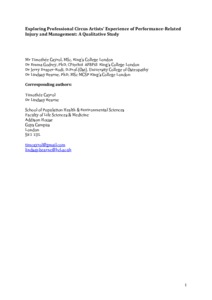Cayrol, T; Godfrey, E; Draper-Rodi, J; Bearne, L
(2019)
Exploring Professional Circus Artists' Experience of Performance-Related Injury and Management: A Qualitative Study.
Med Probl Perform Art, 34 (1).
pp. 14-24.
ISSN 0885-1158
https://doi.org/10.21091/mppa.2019.1004
SGUL Authors: Bearne, Lindsay Mary
![[img]](https://openaccess.sgul.ac.uk/114804/1.hassmallThumbnailVersion/Cayrol%2C%20Godfrey%2C%20Draper-Rodi%2C%20Bearne%20Author%20copy_accepted%20manuscript.pdf)  Preview |
|
PDF
Accepted Version
Available under License ["licenses_description_publisher" not defined].
Download (771kB)
| Preview
|
Abstract
AIMS: Circus is a physically demanding profession, but injury and help-seeking rates tend to be low. This qualitative interview study explored the perceptions and beliefs about injury and help-seeking of circus artists. METHODS: Ten professional circus artists (5 males, 5 females; mean age 33 yrs, range 27-42) were enrolled. Individual, semi-structured interviews were conducted until data saturation of themes was reached. Data were analysed thematically. FINDINGS: Four themes were identified: 1) the injured artist; 2) professionalism; 3) circus life; and 4) artists' experience of healthcare. Most participants described the circus as central to their lives, and injuries had wide-ranging psychosocial consequences. Injury adversely affected participants' mood and threatened their identity. Situational and personal factors (e.g., the belief that pain was normal) pushed participants to use adaptive strategies to perform when injured. Continuous touring and financial constraints affected help-seeking. Easy access to healthcare was rare and participants often self-managed injuries. Experiences of healthcare varied, and participants desired flexible and accessible approaches to prevention and injury management. A modified version of the integrated model of psychological response to injury and rehabilitation process and the concept of identity provided a framework to understand participants. CONCLUSION: Injuries had extensive negative consequences. Work schedules, financial factors, employer support, the artist's perception of the importance of the show, and the relationship between circus and identity influenced injury management and help-seeking. Injury prevention and management strategies could be optimised by developing centres of expertise, online resources, and better regulations of the profession.
| Item Type: |
Article
|
| Keywords: |
Adult, Affect, Art, Athletic Injuries, Female, Humans, Male, Qualitative Research, Humans, Athletic Injuries, Affect, Qualitative Research, Art, Adult, Female, Male, 1103 Clinical Sciences, 1904 Performing Arts and Creative Writing, Orthopedics |
| SGUL Research Institute / Research Centre: |
Academic Structure > Population Health Research Institute (INPH) |
| Journal or Publication Title: |
Med Probl Perform Art |
| ISSN: |
0885-1158 |
| Language: |
eng |
| Dates: |
| Date | Event |
|---|
| March 2019 | Published | | 1 August 2018 | Accepted |
|
| Publisher License: |
Publisher's own licence |
| PubMed ID: |
30826817 |
| Web of Science ID: |
WOS:000465163300003 |
 |
Go to PubMed abstract |
| URI: |
https://openaccess.sgul.ac.uk/id/eprint/114804 |
| Publisher's version: |
https://doi.org/10.21091/mppa.2019.1004 |
Statistics
Item downloaded times since 26 Sep 2022.
Actions (login required)
 |
Edit Item |



